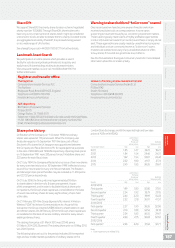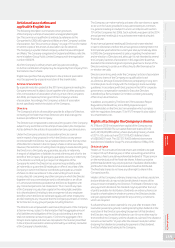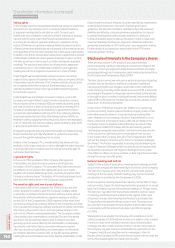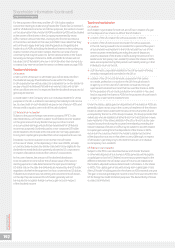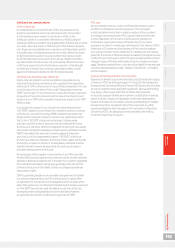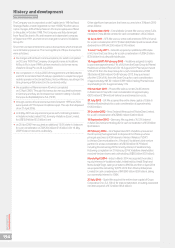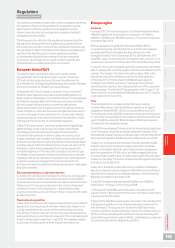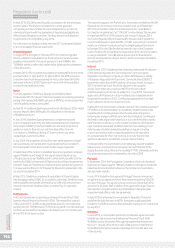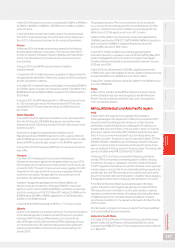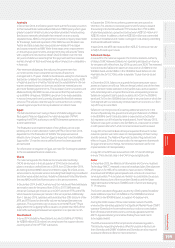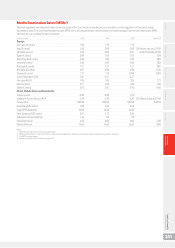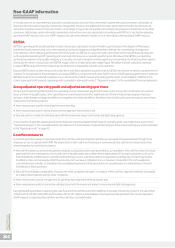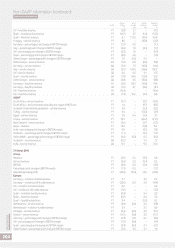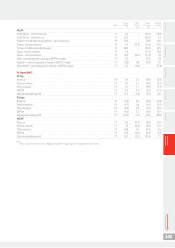Vodafone 2015 Annual Report Download - page 197
Download and view the complete annual report
Please find page 197 of the 2015 Vodafone annual report below. You can navigate through the pages in the report by either clicking on the pages listed below, or by using the keyword search tool below to find specific information within the annual report.
Our operating companies are generally subject to regulation governing
the operation of their business activities. Such regulation typically
takes the form of industry specic law and regulation covering
telecommunications services and general competition (antitrust)
law applicable to all activities.
The following section describes the regulatory frameworks and the
key regulatory developments at the global and supranational level
and in selected countries in which we have signicant interests during
the year ended 31 March 2015. Many of the regulatory developments
reported in the following section involve ongoing proceedings
or consideration of potential proceedings that have not reached
a conclusion. Accordingly, we are unable to attach a specic level
of nancial risk to our performance from such matters.
European Union (‘EU’)
The new European Commission, led by Jean-Claude Juncker,
was appointed in 2014 and will be in place up until 1 November
2019, with Andrus Ansip, the former Estonian Prime Minister the
Vice-President for the Digital Single Market and with Günther Oettinger
as the Commissioner for Digital Economy and Society.
In September 2013, the European Commission (“the Commission”)
delivered major regulatory proposals aimed at building a telecoms
single market and delivering a “Connected Continent”. These proposals
had their rst reading in March 2014 and have since been amended
by the European Parliament and a compromise text has been
produced on behalf of the European Council. From January 2015 the
Latvian Presidency continued discussions with Member States to nd
a common European Council position on the “Connected Continent”
regulatory proposals which are now focused on the abolition of retail
roaming and the introduction of net neutrality regulation.
In May 2016, the European Commission published the Digital Single
Market strategy, aimed at producing a true digital single market.
The strategy is arranged around three pillars: better access for
consumers and businesses to online e-goods and services across
Europe, creating the right conditions for digital networks and services
to ourish and maximising the growth potential of the European digital
economy. As part of this, the Telecoms reform review will start in 2016,
intending to deliver a level playing eld for all market players with
a consistent approach of the rules and to provide economies of scale
for efcient network operators and service providers with an effective
regulatory institutional framework, including a single market approach
to spectrum policy and management. It will also include for the
protection of consumers and the incentivising investment in high speed
broadband networks.
EU recommendations on relevant markets
In October 2014, the EU recommendation to remove ex ante regulation
for voice wholesale markets as they were deemed to be competitive
came into force. (However, these markets can still be reviewed if market
failures occur.) This has seen a reduction in the number of regulated
markets from seven to the following four – xed network access,
business connectivity access and the termination of calls to both mobile
and xed networks.
Fixed network regulation
In May 2014, a Directive on reducing Next Generation Access broadband
deployment costs was passed. It will make it easier and cheaper to roll
out high-speed electronic communications networks by promoting
the joint use of infrastructure, such as electricity, gas, sewage pipes and
existing civil infrastructure of telecoms operators. It has to be transposed
in each member state no later than 1 July 2016. This regulation applies
to all owners of infrastructure whether they are dominant or not.
Europe region
Germany
In January 2015, the national regulator, the Federal Network Authority
(‘BNetzA’) published its nal decision on the auction of 700MHz,
900MHz, 1500MHz, and 1800MHz spectrum. The auction is expected
to be held in May 2015.
BNetzA has approved new Mobile Termination Rates (‘MTRs ‘)
on a preliminary basis, and submitted them to the EU (consolidation
proceedings). BNetzA will release the nal rate decisions with
retrospective effect. From 1 December 2014 to 30 November 2015
the MTR is set at 1.72 eurocents per minute which then reduces to 1.66
eurocents per minute from 1 December 2015 until 30 November 2016.
In July 2014, the vectoring register opened for operators to submit their
plans to deploy VDSL vectoring equipment in Deutsche Telekom’s (‘DT’)
cabinets. The operator that obtains the right to deploy VDSL at the
cabinet level must offer wholesale access to the other operators.
In February 2015, DT led a request to BNetzA to gain approval
for deployment of VDSL vectoring in “near range street cabinets”
preventing other operators from deploying their own VDSL equipment
at the exchange. To offset this DT has proposed to offer a “Layer-2” bit-
stream service on a wholesale basis. BNetzA’s decision on DT’s request
is not expected until June 2015.
Italy
The investigation into an alleged competition issue involving
Vodafone Italy, Telecom Italia and Wind, prompted by a complaint
lodged by an Italian MVNO in 2012, was closed at the end of 2014.
The Antitrust Authority (‘AGCM’) reached the conclusion that there was
no ground for the investigation to be carried on and dismissed the case
against Vodafone, while both Telecom Italia and Wind were required
to implement their proposed changes.
The AGCM is investigating if Telecom Italia has been playing a signicant
role in forcing the companies providing maintenance services of the
xed network to keep their prices articially high to the detriment of the
other licensed operators. AGCM’s decision is expected by June 2016.
In May 2014, the Regional Administrative Tribunal upheld the AGCM
decision which found that Telecom Italia had abused its dominant
position in the xed broadband market. Telecom Italia subsequently
paid the imposed ne of €104 million and led an appeal before the
Council of State. Vodafone Italy’s €1 billion claim against Telecom Italia
is based on this ruling. The Council of State heard the appeal in April and
the ruling is due by July 2015.
In May 2014, the Administrative Tribunal found in favour of Vodafone
Italy, overturning the national regulator’s (‘AGCOM’) injunction that had
required them to adopt all the measures required under the Roaming
Regulation in relation to domestic tariffs.
In July 2014, Vodafone Italy extended its 900MHz and 1800MHz
licences from 1 February 2015 to 30 June 2018.
In February 2015, AGCOM opened the public consultation on the
auction rules for L Band assignment from which the Italian Government
is aiming to raise €700 million.
In March 2015, AGCOM closed its public consultation that will determine
the regulatory guidelines for the mobile termination market over the
next three years. The proposal aims to delete the MTR asymmetry
between operators currently favouring Hutchison 3G Limited; reducing
MTRs on a three year glide path to 0.92 eurocents per minute by 2017
and to dene asymmetrical rates for MVNOs. A nal decision is expected
to be announced and then adopted by July 2016.
Overview Strategy review Performance Governance Financials Additional
information Vodafone Group Plc
Annual Report 2015
195
Regulation
Unaudited information




